
St. Mark's Pastors
- Henry Ziegler
- Joseph Welker
- Joseph Frederick Fahs
- Ferdinand C.H. Lampe
- Abraham Reeser Horne
- William Rickert
- Adolphus Leroy Yount
- George G. Kunkle
- William F. Rick
- Edwin Lunn Miller
- Stephen M. Paulson
- Henry Douglas Spaeth
- Paul L. Yount
- J. Ray Houser
- Robert Neumeyer
- Franklyn S. Lambert
- Frederick G. Hasskarl
- Paul F. Bosch
- William E. Hershey
- Robert Ardell Miller
- Jesse Houck
- Dale E. Johnson
- Stephen F. Yelovich
- Walter L. Brandau
- Kenneth R. Elkin
- James E. West
- Brian D. Vasey
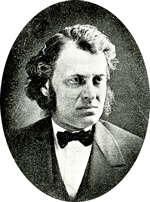
![]() On
April 1, 1865 the dynamic Rev. Abraham Reeser Horne of Turbotville was called
to Williamsport to become pastor of the then “Market St. Lutheran
Church.” President Lincoln had been assassinated the evening before
and the general atmosphere was sad and gloomy. The St. Patrick’s Day
Flood of 1865, which had demolished the first Market Street Bridge
and had thoroughly soaked both the church and parsonage, was still
very fresh in the minds of the congregation who had worked so hard
to put their buildings in a presentable shape for their new pastor.
The terrible Civil War was just drawing to a close, many of the dead
and wounded were being brought home, and Williamsport and St.
Mark’s, not excepted, saw many a sad sight.
On
April 1, 1865 the dynamic Rev. Abraham Reeser Horne of Turbotville was called
to Williamsport to become pastor of the then “Market St. Lutheran
Church.” President Lincoln had been assassinated the evening before
and the general atmosphere was sad and gloomy. The St. Patrick’s Day
Flood of 1865, which had demolished the first Market Street Bridge
and had thoroughly soaked both the church and parsonage, was still
very fresh in the minds of the congregation who had worked so hard
to put their buildings in a presentable shape for their new pastor.
The terrible Civil War was just drawing to a close, many of the dead
and wounded were being brought home, and Williamsport and St.
Mark’s, not excepted, saw many a sad sight.
For three years, services had been conducted in both German and English. Finally the German Church with a membership of 230, thinking she was large enough to support a separate house of worship and pastor of her own, left the English Congregation and built the German Immanuel Church on Basin Street, the Rev. Mr. Zentner being their first pastor.
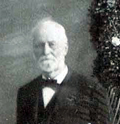 In
1866, Williamsport was incorporated into a city and with the growth
of Williamsport, it is understandable that South Williamsport had
grown too. Streets had been laid out and a school house erected. In
December, 1867 (St. Mark’s then only 15 years old), twelve St.
Mark’s members, living in South Williamsport, separated from the
Mother Church and started their own congregation across the river.
This is now Messiah’s Lutheran Church.
In
1866, Williamsport was incorporated into a city and with the growth
of Williamsport, it is understandable that South Williamsport had
grown too. Streets had been laid out and a school house erected. In
December, 1867 (St. Mark’s then only 15 years old), twelve St.
Mark’s members, living in South Williamsport, separated from the
Mother Church and started their own congregation across the river.
This is now Messiah’s Lutheran Church.
In 1868, in spite of these two divisions, Pastor Horne recorded a communicant membership of 307.
About this same time, the storm which had been gathering momentum for some time in the Lutheran Church over the “Augsburg Confession” (worship, customs, doctrine, and polity) finally broke. One group of Lutherans being of an American type mind, eager for progress and success and willing to throw overboard as an encumbrance the priceless heritage left by the fathers, and the other group having the German spirit, clinging tenaciously to the tradition of the elders, clashed over these churchly principles.
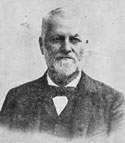 St.
Mark’s Church lay in the path of the storm and it became necessary
to choose the group with which they would affiliate. The majority
voted to unite with the Ministerium of Pennsylvania and the General
Council, but the minority who did not wish this move withdrew.
Uniting with the General Synod, they organized a new church of their
own. The result was a split in the church, the first group
remaining with the General Synod, subscribing to the Augsburg
Confession with some reservations, and the latter group breaking
away to form the St. Paul’s Lutheran Church. On April 30, 1871, the
second division of St. Mark’s was accomplished with the birth of St.
Paul’s, the Rev. Joel Swartz being their first pastor. St. Paul’s
was the second English speaking Lutheran Church in Williamsport, and
it is well to note that both congregations worked together to
further the work of the Gospel in Williamsport.
St.
Mark’s Church lay in the path of the storm and it became necessary
to choose the group with which they would affiliate. The majority
voted to unite with the Ministerium of Pennsylvania and the General
Council, but the minority who did not wish this move withdrew.
Uniting with the General Synod, they organized a new church of their
own. The result was a split in the church, the first group
remaining with the General Synod, subscribing to the Augsburg
Confession with some reservations, and the latter group breaking
away to form the St. Paul’s Lutheran Church. On April 30, 1871, the
second division of St. Mark’s was accomplished with the birth of St.
Paul’s, the Rev. Joel Swartz being their first pastor. St. Paul’s
was the second English speaking Lutheran Church in Williamsport, and
it is well to note that both congregations worked together to
further the work of the Gospel in Williamsport.
Interestingly, in his History of Lycoming County, Pennsylvania, 1892, p. 410, John F Meginness pointed to Rev. Horne's involvement with the Williamsport public schools:
In 1868 the [Williamsport] school board passed a resolution to elect a superintendent of the city schools according to the act of 1867. June 6, 1868, Rev. A. R. Horne, an experienced teacher, was selected. When he went into office there were only forty-two schools. In June, 1872, he was succeeded by Prof. J. F. Davis.
In 1871, Rev. Horne received a call to the position of President of Kutztown Normal School, and after one of the most eventful pastorates in its history, severed his connections with St. Mark’s.
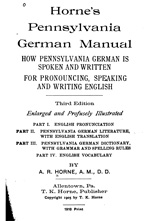
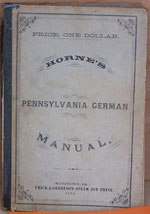 Rev. Horne apparently became a proponent of bilingual education,
particularly with respect to the Pennsylvania Germans. He
wrote on the subject while a professor in Kutztown. In 1875 he
authored a text entitled, Pennsylvania German manual, for
pronouncing, speaking and writing English, a seminal volume on
the subject matter, which was printed in four separate editions
through 1910 The volume was recently republished, in 2007.
Google has scanned the text of the 1905 edition.
Rev. Horne apparently became a proponent of bilingual education,
particularly with respect to the Pennsylvania Germans. He
wrote on the subject while a professor in Kutztown. In 1875 he
authored a text entitled, Pennsylvania German manual, for
pronouncing, speaking and writing English, a seminal volume on
the subject matter, which was printed in four separate editions
through 1910 The volume was recently republished, in 2007.
Google has scanned the text of the 1905 edition.
He returned to the church for the fiftieth anniversary in 1902 and was photographed in the sanctuary of the 1896 church.